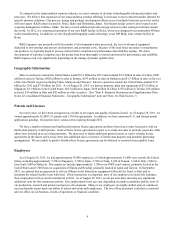Crucial 2013 Annual Report Download - page 19
Download and view the complete annual report
Please find page 19 of the 2013 Crucial annual report below. You can navigate through the pages in the report by either clicking on the pages listed below, or by using the keyword search tool below to find specific information within the annual report.18
• the assumption of unknown or underestimated liabilities;
• the use of cash to finance a transaction, which may reduce the availability of cash to fund working capital, capital
expenditures, research and development expenditures and other business activities;
• diverting management's attention from normal daily operations;
• managing larger or more complex operations and facilities and employees in separate and diverse geographic areas;
• hiring and retaining key employees;
• requirements imposed by governmental authorities in connection with the regulatory review of a transaction, which
may include, among other things, divestitures or restrictions on the conduct of our business or the acquired business;
• inability to realize synergies or other expected benefits;
• failure to maintain customer, vendor and other relationships;
• inadequacy or ineffectiveness of an acquired company's internal financial controls, disclosure controls and procedures,
and/or environmental, health and safety, anti-corruption, human resource, or other policies or practices; and
• impairment of acquired intangible assets and goodwill as a result of changing business conditions, technological
advancements or worse-than-expected performance of the acquired business.
In recent years, supply of memory products has significantly exceeded customer demand resulting in significant declines in
average selling prices for DRAM, NAND Flash and NOR Flash products. Resulting operating losses have led to the
deterioration in the financial condition of a number of industry participants, including the liquidation of Qimonda AG and the
2012 bankruptcy filing by Elpida Memory, Inc. These types of proceedings often lead to confidential court-directed processes
involving the sale of related businesses or assets. We believe the global memory industry is experiencing a period of
consolidation as a result of these market conditions and other factors, and we may engage in discussions regarding potential
acquisitions and similar opportunities arising out of these industry conditions. To the extent we are successful in completing
any such transactions, we could be subject to some or all of the risks described above, including the risks pertaining to funding,
assumption of liabilities, integration challenges and increases in debt that may accompany such transactions. Acquisitions of,
or alliances with, high-technology companies are inherently risky and may not be successful and may materially adversely
affect our business, results of operations or financial condition.
Our future success depends on our ability to develop and produce competitive new memory technologies.
Our key semiconductor memory technologies of DRAM, NAND Flash and NOR Flash face technological barriers to
continue to meet long-term customer needs. These barriers include potential limitations on the ability to shrink products in
order to reduce costs, meet higher density requirements and improve power consumption and reliability. To meet these
requirements, we expect that new memory technologies will be developed by the semiconductor memory industry. Our
competitors are working to develop new memory technologies that may offer performance and/or cost advantages to our
existing memory technologies and render existing technologies obsolete. Accordingly, our future success may depend on our
ability to develop and produce viable and competitive new memory technologies. There can be no assurance of the following:
• that we will be successful in developing competitive new semiconductor memory technologies;
• that we will be able to cost-effectively manufacture new products;
• that we will be able to successfully market these technologies; and
• that margins generated from sales of these products will allow us to recover costs of development efforts.
If our efforts to develop new semiconductor memory technologies are unsuccessful, our business, results of operations or
financial condition may be adversely affected.
























